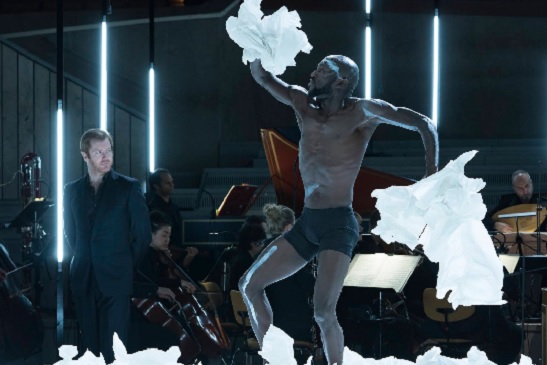
A performance of Messiah in Berlin that Frederic Wake-Walker produced
Photo: Kai Bienert
My Gurus: ‘the route less travelled’
Mahogany Opera Artistic Director Frederic Wake-Walker looks back at the people who taught him to make art like you're making history.
Benjamin Britten
Benjamin hovered over my childhood like a loving yet stern grandfather, even though I never met him. Growing up where he lived, meeting and working with many of his closest colleagues, and singing in some of his operas as a child had a profound effect on my upbringing. Playing a boy possessed by an abusive ghost and then dying in the arms of a soprano was a pretty intense experience for an 11-year old! The economy of Benjamin’s writing and the intensity with which he brings music and drama together have informed my directing, especially when making new work with living composers, but his greatest influence on me is perhaps his work with communities and children. An early pioneer of participatory art, he wanted his music to be “useful to the living” – just as essential to communities as schools and hospitals. Bringing young people and professionals together for totally inclusive projects without compromising on quality has been a major focus of my career and I owe a huge debt of thanks to Benjamin for that inspiration.
Richard Demarco
Richard was regarded as something of a legend by us students at Edinburgh University. He was the promoter of the Roxy Art House when I directed and produced my first ever opera at the Fringe in 2003. I did everything myself – built the set, booked the orchestra, hung the lights, took the publicity shot – and was bitten by the opera producing bug. Among Richard’s pearls of wisdom are that “art is an excuse for friendship and love” and “if you’re going to make art then make it like you’re making history”. He inspires a freedom of expression in me and always reminds me that art is a language that is a vital component in binding us all together. He once challenged me to establish opera and music theatre as a major art form at the Edinburgh Fringe. I’m still working on that one.
… there were no restrictions on our use of the building – by the end of the summer we’d been involved with 350 productions and more than 2000 artists
Mara Amats
Mara walked into my life and left this world just three years later. She designed the set and costumes for Curley River, my first professional production with Mahogany. As a visual artist specialising in making her own paper and combining found, natural objects, she brought a unique perspective to stage design. Born in Latvia, Mara had spent the second world war in a German labour camp, studied Russian iconography and worked with artists across Africa and Asia, promoting their work to help sustain their communities. When I was a young, ambitious director, she made me realise that the less-travelled route may be the more interesting one to take. Working with Mara sparked my ongoing fascination with Japanese theatre. She introduced me to Vsevolod Meyerhold and Andrei Rublev and taught me to create images that allow for multiple interpretations. She embodied roughness and holiness. She was a true friend of mine and I still miss her terribly.
Stephen Lawless and Glyndebourne
Without Stephen and the people I met through him I would still be working out a lot of things in directing. His humour, craft and perceptiveness have given me the tools to face the complex machinations of any opera house. In my first year out of university I followed Stephen to Buxton, Innsbruck, New York and finally Glyndebourne. Between 2006 and 2014 I worked at Glyndebourne nearly every year, honing my technique and working on new commissions until I was given my big break. The hardest step for a young opera director is to be given a main stage show and I’m eternally grateful to David Pickard for sticking his neck out. I also met Robin Ticciati, conductor for La Finta Giardiniera during Stephen’s production of Die Fledermaus on the Glyndebourne Tour in 2006. Finta was taken up by La Scala, Milan last year and I’m flying to China soon to re-mount it at the Shanghai International Festival. I sometimes wonder if I’ll ever make another production as good again!
Christophe Knoch and Mica Moca
Christophe moved to Berlin two months before I did. Knowing he had a spare room certainly gave me the final nudge I needed to take the leap. We both noticed the vast, abandoned warehouse independently but it was Christophe who tracked down the owner and secured the use of the space for six months. In the contract, Christophe insisted there was a clause that meant there were no restrictions on our use of the building – by the end of the summer we’d been involved with 350 productions and more than 2000 artists. Mica Moca was born during that summer in 2011 when I felt my life had cracked open. I met a plethora of superb artists from the Berlin independent scene, many of whom – Ahmed Soura, Minako Seki, Rosabel Huguet, Etoile Chaville, Johannes Lauer, Sylwek Luczak, Ming Poon – I’ve continued to work with. One of them I even married!
Frederic Wake-Walker is an international director and producer of opera, contemporary music theatre and multi-disciplinary performance. He is Artistic Director of Mahogany Opera and one of the team behind Mica Moca.

Join the Discussion
You must be logged in to post a comment.